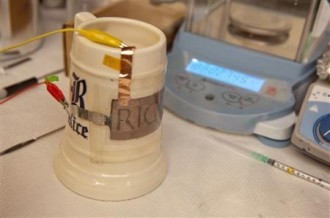A team of researchers at Rice University in Houston, Texas have developed a type of paint that can store and deliver electrical power much like a conventional battery. The scientists were able to break down the individual components in a battery and reorganize them into a paint that can be sprayed onto nearly any surface, layer by layer.
The technology works much like a regular battery, except that each layer is effectively flattened. A spray-on battery consists of two current collectors, a cathode, an anode and a polymer separator in the center.
The team demonstrated the paint batteries by applying them to all sorts of surfaces, including glass and stainless steel as well as curved surfaces such as a coffee mug. In another test, they sprayed six bathroom tiles with the paint, connected them all together and used the juice to power a set of LEDs for six hours at a constant 2.4 volts.
We are told that a dry and oxygen-free environment is needed to create the battery and the liquid electrolytes can be difficult to handle. Research is continuing with the hope of finding the correct combination of materials that will allow them to eliminate the oxygen-free requirement, resulting in a more efficient production process and extended commercial viability.
Project leader Pulickel Ajayan points out that this rechargeable battery technology will allow gadget makers to further slim down designs as they won't be required to make room for traditional lithium-ion or alkaline style batteries.
A full breakdown of the team's study can be found in Thursday's edition of Nature Scientific Reports.
